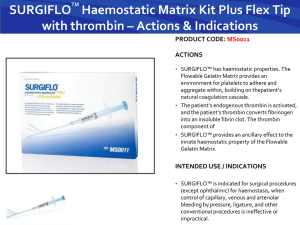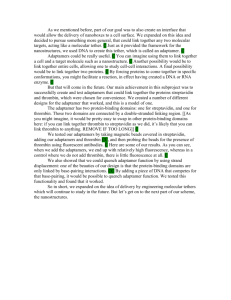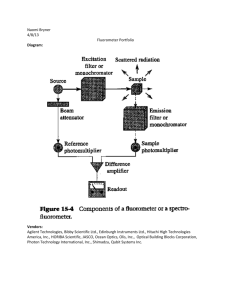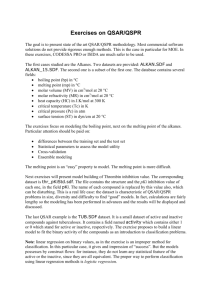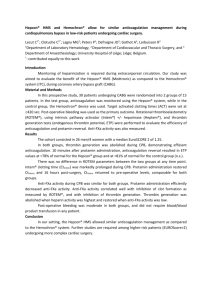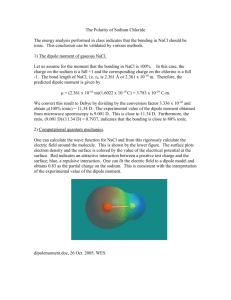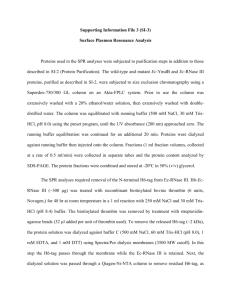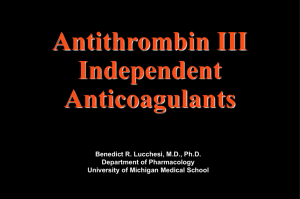Electrostatic Dependence of the Thrombin
advertisement
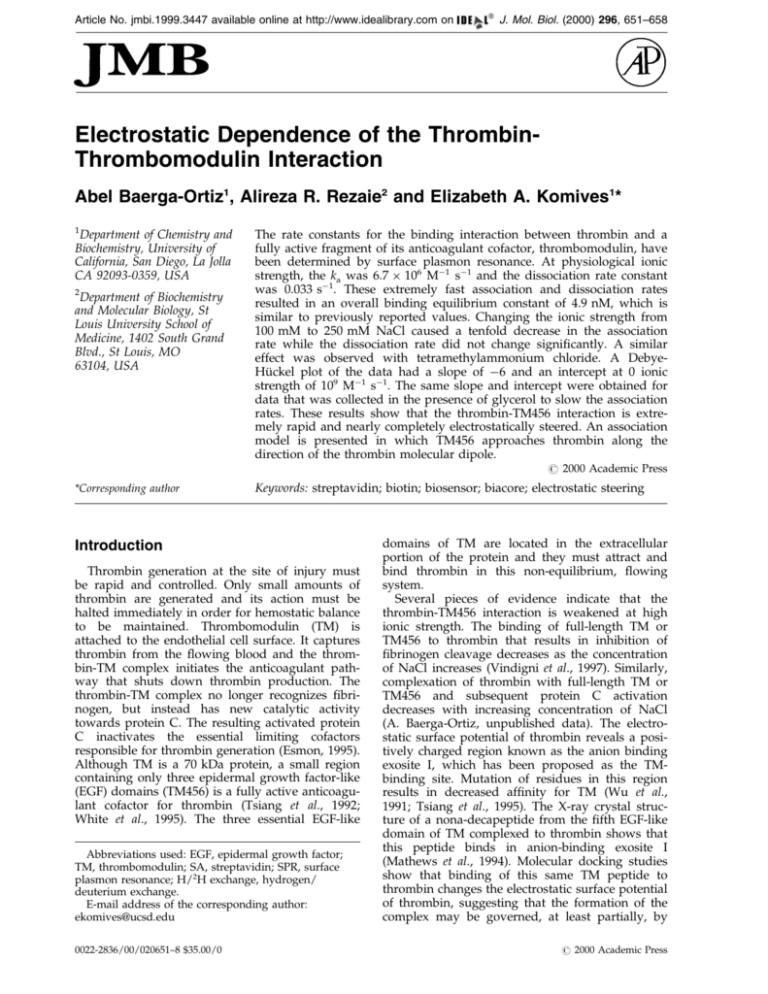
Article No. jmbi.1999.3447 available online at http://www.idealibrary.com on J. Mol. Biol. (2000) 296, 651±658 Electrostatic Dependence of the ThrombinThrombomodulin Interaction Abel Baerga-Ortiz1, Alireza R. Rezaie2 and Elizabeth A. Komives1* 1 Department of Chemistry and Biochemistry, University of California, San Diego, La Jolla CA 92093-0359, USA 2 Department of Biochemistry and Molecular Biology, St Louis University School of Medicine, 1402 South Grand Blvd., St Louis, MO 63104, USA The rate constants for the binding interaction between thrombin and a fully active fragment of its anticoagulant cofactor, thrombomodulin, have been determined by surface plasmon resonance. At physiological ionic strength, the ka was 6.7 106 Mÿ1 sÿ1 and the dissociation rate constant was 0.033 sÿ1. These extremely fast association and dissociation rates resulted in an overall binding equilibrium constant of 4.9 nM, which is similar to previously reported values. Changing the ionic strength from 100 mM to 250 mM NaCl caused a tenfold decrease in the association rate while the dissociation rate did not change signi®cantly. A similar effect was observed with tetramethylammonium chloride. A DebyeHuÈckel plot of the data had a slope of ÿ6 and an intercept at 0 ionic strength of 109 Mÿ1 sÿ1. The same slope and intercept were obtained for data that was collected in the presence of glycerol to slow the association rates. These results show that the thrombin-TM456 interaction is extremely rapid and nearly completely electrostatically steered. An association model is presented in which TM456 approaches thrombin along the direction of the thrombin molecular dipole. # 2000 Academic Press *Corresponding author Keywords: streptavidin; biotin; biosensor; biacore; electrostatic steering Introduction Thrombin generation at the site of injury must be rapid and controlled. Only small amounts of thrombin are generated and its action must be halted immediately in order for hemostatic balance to be maintained. Thrombomodulin (TM) is attached to the endothelial cell surface. It captures thrombin from the ¯owing blood and the thrombin-TM complex initiates the anticoagulant pathway that shuts down thrombin production. The thrombin-TM complex no longer recognizes ®brinogen, but instead has new catalytic activity towards protein C. The resulting activated protein C inactivates the essential limiting cofactors responsible for thrombin generation (Esmon, 1995). Although TM is a 70 kDa protein, a small region containing only three epidermal growth factor-like (EGF) domains (TM456) is a fully active anticoagulant cofactor for thrombin (Tsiang et al., 1992; White et al., 1995). The three essential EGF-like Abbreviations used: EGF, epidermal growth factor; TM, thrombomodulin; SA, streptavidin; SPR, surface plasmon resonance; H/2H exchange, hydrogen/ deuterium exchange. E-mail address of the corresponding author: ekomives@ucsd.edu 0022-2836/00/020651±8 $35.00/0 domains of TM are located in the extracellular portion of the protein and they must attract and bind thrombin in this non-equilibrium, ¯owing system. Several pieces of evidence indicate that the thrombin-TM456 interaction is weakened at high ionic strength. The binding of full-length TM or TM456 to thrombin that results in inhibition of ®brinogen cleavage decreases as the concentration of NaCl increases (Vindigni et al., 1997). Similarly, complexation of thrombin with full-length TM or TM456 and subsequent protein C activation decreases with increasing concentration of NaCl (A. Baerga-Ortiz, unpublished data). The electrostatic surface potential of thrombin reveals a positively charged region known as the anion binding exosite I, which has been proposed as the TMbinding site. Mutation of residues in this region results in decreased af®nity for TM (Wu et al., 1991; Tsiang et al., 1995). The X-ray crystal structure of a nona-decapeptide from the ®fth EGF-like domain of TM complexed to thrombin shows that this peptide binds in anion-binding exosite I (Mathews et al., 1994). Molecular docking studies show that binding of this same TM peptide to thrombin changes the electrostatic surface potential of thrombin, suggesting that the formation of the complex may be governed, at least partially, by # 2000 Academic Press 652 electrostatics (Sampoli Benitez et al., unpublished data). The in¯uence of electrostatics has been analyzed for several different protein-protein interactions (Raman et al., 1992; Schreiber & Fersht, 1996; Radic et al., 1998; Perrett et al., 1998; Xavier et al., 1998, 1999). Four of the interactions studied were antibody-antigen complexes and two were enzymeinhibitor complexes. Perrett et al. (1997) studied the interaction of unfolded barnase with GroEL. For all the interactions that have Kd values in the nanomolar range, the dissociation rates were slow (on the order of 10ÿ4-10ÿ5 sÿ1), and unaffected by changes in ionic strength. The association rates as measured by either ka or kobs, decreased with increasing ionic strength. The log ka decreased linearly with the square root of ionic strength in accord with DebyeHuÈckel theory. The interaction of thrombin with TM differs in a signi®cant way from the previously studied interactions for which the functional goal is irreversibility. The thrombin-TM interaction is an enzyme-cofactor interaction that should be rapidly reversible so that the cofactor can activate many enzyme molecules. In the case of the thrombin-TM interaction, a third player, the irreversible inhibitor antithrombin III, may inhibit thrombin while bound to TM. The rapid disengagement of TM from the inhibited thrombin is thus also critical. We present real time kinetic measurements from surface plasmon resonance (SPR) experiments carried out at different NaCl and (CH3)4NCl concentrations that allow quantitative measurement of the electrostatic effects of the thrombin-TM456 interaction. The results presented here agree with previous equilibrium binding experiments and show that the thrombin-TM interaction is rapid and highly electrostatically steered. Results Thrombin and thrombin inhibited with PPACK show identical kinetics of interaction with biotinylated TM456 coupled to the SA sensor chip In order to obtain a homogeneous distribution of protein molecules on the surface of the SPR sensor chip, a coupling strategy involving biotinylation of TM456 was chosen. Fortuitously, TM456 contains no lysine residues, so biotin with an LC-LC linker arm was covalently attached only to the N terminus of TM456. Thus, all TM456 molecules bound to streptavidin (SA) on the sensor chip surface were linked to the surface in the same manner and extended far enough from the SA surface to allow protein-protein interaction to occur. Indeed, thrombin interaction with TM456 bound to the SA chip with the shorter biotin-LC-linker was impaired. Nanomolar concentrations of thrombin in buffer containing 150 mM NaCl were ¯owed over a sur- The Thrombin-Thrombomodulin Interaction face containing 370 resonance units of immobilized biotinylated TM456. Identical curves for association and dissociation were obtained for active thrombin compared to thrombin that had been inactivated with D-Phe-Pro-Arg -chloromethylketone (PPACK) (data not shown). Very similar kinetics were also observed for human thrombin. For the thrombinTM456 interaction, pseudo ¯owing equilibrium was attained even at concentrations of thrombin below the expected Kd, and the ka and kd were extremely fast compared to most protein-protein interactions. In order to guard against mass transport limitation under these rapid binding conditions, very low amounts of TM456 were immobilized on the surface, and the highest possible ¯ow rates were used. One dif®culty in studying the ionic strength dependence of the thrombin-TM interaction is that thrombin binds sodium with a binding af®nity in the millimolar range (Wells & DiCera, 1992). Sodium binding alters the enzymatic activity of thrombin as well as the binding af®nity of TM (Vindigni et al., 1997). Measurement of binding kinetics at different ratios of NaCl to (CH3)4NCl keeping the ionic strength constant gave identical values of ka and kd regardless of sodium concentration (data not shown). From this we concluded that PPACK-inactivated thrombin did not show a sodium effect on the interaction with TM456. By using PPACK-inactivated thrombin for the binding kinetics measurements, it was possible to study solely the electrostatic effects of altering the NaCl concentration without complications from sodiumbinding phenomena. Effects of NaCl and (CH3)4NCl on the binding kinetics Binding kinetic constants for the thrombinTM456 interaction were determined at ®ve different thrombin concentrations and at different concentrations of NaCl and (CH3)4NCl ranging from 100 to 250 mM. Examples of the global ®ts for a set of data from lower ionic strength (150 mM) and higher ionic strength (250 mM) are shown in Figure 1. The residuals were low, and highly reproducible kinetic constants were obtained from global ®ts of all data sets. Data from a representative set of data collected at different concentrations of NaCl are presented in Table 1 and at different concentrations of (CH3)4NCl in Table 2. Three different experiments were performed on two different Biacore SPR instruments with different preparations of proteins, and the results were very reproducible. Within error, the kd remained constant at approx. 0.03 sÿ1 (Figure 2). The ka decreased an order of magnitude from 1.8 107 Mÿ1 sÿ1 to 1.8 106 Mÿ1 sÿ1 as the ionic strength was increased from 100 to 250 mM (Figure 3). Whether the ionic strength was increased by addition of NaCl or (CH3)4NCl, the log of the association constant decreased linearly with 653 The Thrombin-Thrombomodulin Interaction Figure 2. Plot of log kd versus the ionic strength from 100 to 250 mM using either (*), NaCl or ( & ), (CH3)4NCl. Each was the average of at least two experiments of globally ®tted data from ®ve different PPACK-thrombin concentrations as described in Materials and Methods. The error bars are the standard deviation from the mean for the determinations. One example of the raw data is shown in the inset. Figure 1. Sensorgrams of PPACK-thrombin in 10 mM Hepes buffer with (a) 150 mM NaCl or (b) 250 mM NACl ¯owed at 100 ml/minute over 370 RU of biotinylated TM456 bound to the streptavidin surface. Thrombin concentrations were 0.78 (black), 1.56 (blue), 3.125 (green), 6.5 (orange) and 12.5 nM (red) for the 150 mM NaCl experiment. Thrombin concentrations were 6.0 (orange), and 12.5 nM (red), 25.0 (cyan) and 50.0 nM (purple) for the 250 mM NaCl experiment. The data were ®t globally using the Langmuir 1:1 binding model in Biaevaluation 3.0. Control experiments in which the same concentrations of thrombin were ¯owed over a surface containing only biotin were subtracted from the sample data. increasing ionic strength and the data ®t a simple Debye-HuÈckel model giving a slope of ÿ6 (Figure 4). Because the ka for the thrombin-TM456 interaction was so high and subject to limitations of measurement by SPR, con®rmatory experiments were also performed at various glycerol concentrations. Glycerol was expected to increase the viscosity and therefore decrease the ka measured at each ionic strength. Shown also in Figure 4 are the data obtained at 20 % (w/v) glycerol. The slope of all the Debye-Huckel plots was ÿ6. The intercept at 0 glycerol and ionic strength was 109 Mÿ1 sÿ1 indicating that the association of thrombin with TM456 is highly electrostatically steered. Discussion Protein-protein interactions can be classi®ed according to their functional consequences. Antibody-antigen interactions, such as the well-studied HYEL-5-lysozyme interaction, result in removal of the antigenic protein from the circulation. Enzymeinhibitor interactions such as acetylcholinesterasefasciculin and barnase-barstar result in inhibition of enzymatic activity. The functional goal of these types of protein-protein interactions is irreversibility, and therefore the kd for these interactions is slow. On the other hand, enzyme-cofactor interactions such as the thrombin-TM456 interaction, should be rapidly reversible so that the cofactor can activate many enzyme molecules. Thus, it is not surprising that the kd for the thrombin-TM456 interaction is several orders of magnitude faster, approximately 0.03 sÿ1, than reported kd values of 10ÿ4-10ÿ5 sÿ1 for functionally inhibitory interactions (Table 3). In order to achieve high af®nity binding, the ka for an enzyme-cofactor interaction must be commensurately high; 107 Mÿ1 sÿ1 for the thrombin-TM456 interaction. In theory, large proteins the size of thrombin and TM would undergo many unproductive encounters and since few collisions would be productive, the resulting ka would be slow (Janin, 1997; McCammon, 1998). Electro- 654 The Thrombin-Thrombomodulin Interaction Table 1. Kinetic constants for PPACK-thrombin binding to 370 response units of TM456 NaCl (mM) 100 125 150 175 200 225 250 ka (Mÿ1 sÿ1) 7 1.5 10 2.2 107 6.7 106 4.9 106 2.2 106 2.2 106 1.8 106 kd (sÿ1) Kd (nM) w2 Rmax 0.026 0.025 0.033 0.030 0.029 0.034 0.062 1.8 1.1 4.9 6.1 13.4 15.8 35.3 2.03 0.78 0.47 1.17 0.49 0.19 1.62 42.1 20.2 22.6 20.2 24.9 20.2 17.5 Table 2. Kinetic constants for PPACK-thrombin binding to 370 response units of TM456 (CH3)4NCl (mM) 100 125 150 175 200 225 250 ka (Mÿ1 sÿ1) 7 1.8 10 1.2 107 8.1 106 6.8 106 4.8 106 2.2 106 2.3 106 kd (sÿ1) Kd (nM) w2 Rmax 0.021 0.020 0.023 0.022 0.033 0.043 0.044 1.2 1.6 2.8 3.2 6.8 20.0 19.0 2.53 2.61 2.46 1.38 0.89 0.80 1.25 37.7 29.3 24.9 22.5 23.8 26.1 23.4 static steering is one effective way to increase the probability of productive encounters and achieve higher ka values and higher interaction af®nities. SPR provides an excellent way to measure rapid protein-protein interaction kinetics in a non-equili- brium ¯owing system. Data can be collected at a 5 Hz sampling rate, and at a ¯ow rate of 100 ml/ minute. Furthermore, the ka and the kd can be accurately measured under the same conditions (Pearce et al., 1996; Schuck & Minton, 1996; for reviews, see Raghavan & Bjorkman, 1995; Szabo et al., 1995). A gauge of the reliability of the kinetic values obtained can be seen from comparison of the ionic strength dependence of the Kd obtained by SPR compared to that measured by binding competition (Figure 5). Figure 3. Plot of log ka versus the ionic strength from 100 to 250 mM using either (*), NaCl or ( & ), (CH3)4NCl. Each was the average of at least two experiments of globally ®tted data from ®ve different PPACK-thrombin concentrations as described in Materials and Methods. The error bars are the standard deviation from the mean for the determinations. One example of the raw data is shown in the inset. Figure 4. Debye-HuÈckel plot of the log ka versus the square root of the ionic strength. The ionic strength was varied from 125 to 250 mM using either (*), NaCl or ( & ), (CH3)4NCl. In a separate experiment, the ionic strength was varied from 125 to 250 mM using NaCl in the presence of 20 % glycerol (^). Each experiment was repeated and the error bars are the standard deviation from the mean for the two determinations. 655 The Thrombin-Thrombomodulin Interaction Table 3. Summary of studies on the ionic strength dependence of various protein-protein interactions Protein Cyt. c (ox)/mAb2B5 Cyt. c (ox)/mAb5F8 Barnase/Barstar HE-lysozyme/mAbHY-5 AchE/Fasciculin BWQ-lysozyme/mAbHY-5 Thrombin/TM456 kd (sÿ1)a ÿ5 3-12 10 1 10ÿ4 1.5 10ÿ5 2.2 10ÿ4 7 10ÿ5 0.96 3.3 10ÿ2 ka (Mÿ1 sÿ1) 5 6.5 10 1.5 106 1.35 106 1.5 107 2 106 1.8 107 6.7 106 Debye-Huckel slope ÿ2 NDb ÿ2.5 ÿ0.5 ÿ4.8 ÿ0.5 ÿ6 Reference Raman et al. (1992) Raman et al. (1992) Schreiber & Fersht (1993) Xavier et al. (1998) Radic et al. (1998) Xavier et al. (1999) This report We apologize if some studies were not included here. The values reported for kd and ka are those measured at 150 mM ionic strength. b ND means not determined. a One interesting result from these experiments is that the thrombin-TM456 interaction kinetics indicate a very high degree of electrostatic steering. The slopes of all the Debye-HuÈckel plots were highly reproducible with an average value of ÿ6.0 /ÿ 0.6, which is the largest ever reported for a protein-protein association. The Einstein-Smoluchowski equation predicts that the rate of encounter for two spheres in water at 300 K is independent of the size of the spheres and is approx. 6.6 109 Mÿ1 sÿ1. Extrapolation of the Debye-HuÈckel plot for the thrombin-TM456 interaction gives an association rate constant at zero ionic strength of 109 Mÿ1 sÿ1, a value that approaches the Smoluchowski limit. It therefore appears that the thrombin-TM456 interaction has approached the limit of electrostatic steering, and that almost every encounter is a productive one. In trying to rationalize these results on the basis of the structure of thrombin, a second interesting result was attained. The structure of the thrombinTM456 complex is not known, and thrombin has two highly positively charged patches on the surface, each of which might attract the TM456 molecule. We recently completed hydrogen/deuterium Figure 5. Comparison of the dependence of log Kd versus the square-root of the ionic strength for the thrombin-TM456 interaction determined by (*), inhibition competition assays (Vindigni et al., 1997) and ( & ), determined in this report by SPR. (H/2H) exchange experiments that provided information about sites on the thrombin molecule where TM456 binds. These experiments showed two regions of thrombin that interact with TM fragments; the anion-binding exosite I and a loop near the active site containing the sequence WRENL (residues 96-100 in the chymotrypsin numbering system) (Mandell et al., 1998). This ``footprint'' of TM45 on thrombin is shown in Figure 6(a). The two discontinuous sites of TM interaction are each near one of the positively charged patches. Based on these H/2H exchange experiments, we proposed that TM456 binds in a manner that connects these two regions (Mandell et al., 1998). Interestingly, the positive end of the overall molecular dipole of thrombin extends from the molecule exactly in the middle of the proposed binding site that connects the two discontinuous footprints of TM456 (Figure 6(b)). This intriguing result begs the hypothesis that TM456 approaches thrombin along the direction of the molecular dipole, and that this direction of approach would position TM456 perfectly for binding. To test this hypothesis, we measured the binding kinetics of TM456 to two mutant thrombins. The R97A mutation lies on a surface loop outside the active site and makes contacts to ®brinopeptide A (He et al., 1997) and is in the WRENL loop that showed slowed H/2H exchange in the thrombinTM45 complex (Mandell et al., 1998). The K70D mutation is in anion-binding exosite I and in structures of thrombin, it appears to be participating in a salt bridge with E80. Calculation of the molecular dipole of each of the mutant thrombins showed that for one, the R97A mutant, only the magnitude of the dipole changed but the direction remained constant. For the other, the K70D mutant, both the direction and the magnitude of the dipole changed. One would predict that if the direction of the thrombin molecular dipole were important, the effect of the K70D mutation on binding of TM456 would be more drastic. Furthermore, one would predict that both the ka and kd would change equally for the R97A mutant. Both of these predictions were shown to be true (Table 4). Clearly more work needs to be done to establish the role of individual residues on TM binding to thrombin as well as to con®rm the molecular dipole hypoth- 656 The Thrombin-Thrombomodulin Interaction et al., 1995). Biotinylation was carried out using the EZLink sulfoNHS-LC-LC biotinylation kit from Pierce Chemicals (Rockford, IL) according to the instructions provided with the kit. Typically, 90 mg of lyophilized TM456 prepared by dissolution in 180 ml of H2O was reacted with 21 ml of 0.018 M NHS-LC-LC-Biotin for two hours at 4 C. Reaction products were puri®ed on a Vydac C18 (4.6 mm 250 mm) analytical reverse-phase HPLC column at a ¯ow rate of 1 ml/minute of 100 % buffer A (0.1 % tri¯uoroacetic acid) for ten minutes followed by a gradient consisting of 0.1 % tri¯uoroacetic acid to 50 % (v/v) acetonitrile over 45 minutes. A single peak was recovered and assayed both for TM456 activity (White et al., 1995) and for the degree of biotinylation by the 2-(40 -hydroxyazo-benzene) benzoic acid assay as described in the biotinylation kit. The yield of puri®ed, modi®ed TM456 was approximately 35 %. The biotin label did not have any effect on the cofactor activity of TM456 in a protein C activation assay. Coupling of biotin-labelled TM456 to the sensor chip Figure 6. (a) Structure of thrombin showing the regions of thrombin for which solvent exclusion occurred upon binding of TM45. TM45 is a two-EGF domain fragment of TM that binds somewhat more weakly to thrombin than TM456, the three EGF-domain fragment. (b) Electrostatic potential map for thrombin showing the overall molecular dipole. The thrombin molecules shown in (a) and (b) are in the same orientation. esis. Importantly, mutations far from the proposed TM binding surface need to be studied. Nevertheless, kinetic, structural, and mutational data are so far consistent with the idea that the thrombinTM456 interaction is highly electrostatically steered along the direction of the thrombin molecular dipole. Materials and Methods Synthesis of biotin-labelled TM456 TM456 was expressed in the Pichia pastoris yeast expression system and puri®ed to homogeneity as described (White et al., 1995). TM456 shows full TM activity in solution in both thrombin binding assays and protein C activation assays (Vindigni et al., 1997; White Coupling of TM456 to the gold surface of the sensor chip was achieved by ¯owing 1 mg/ml (59 nM) of biotin-labeled TM456 in 10 mM Hepes buffer, 300 mM NaCl, 2.5 mM CaCl2 (pH 7.4), over a SA sensor chip (Biacore Inc., Piscataway, NJ). The amount of TM456 immobilized was determined after washing to be 370 units. Coupling was carried out at 300 mM NaCl in order to collapse the dextran matrix and thus minimize artifacts that might occur during the experiments at different ionic strengths. Because the TM456 is highly glycosylated, this value can not be easily translated into an amount of protein on the chip. Surfaces were also prepared with only 150 units of immobilized TM456 and the interaction kinetics measured at these very low amounts of TM456 were the same as at 370 resonance units. A control surface was prepared by ¯owing free biotin (0.003 mg/ml) over a second channel of the SA sensor chip and data from this ``blank'' channel was subtracted from the sample data. Preparation of thrombin Bovine thrombin was prepared as described by Ni et al. (1990) and puri®ed by chromatography on a MonoS 10/10 column using a gradient of 100 mM to 500 mM NaCl in NaKPO4 buffer (pH 6.5). Thrombin eluted from the column at approximately 250 mM NaCl, and was concentrated to 1.5 mg/ml and stored in small portions at ÿ70 C. Human thrombin was a generous gift of J. Fenton, and was puri®ed as described for the bovine thrombin before use. During the SPR experiments, we discovered that thrombin, both active and after inactivation with PPACK was relatively unstable. Thrombin that had been stored at ÿ20 C for more than three weeks, or had been dialyzed was unsuitable for SPR analysis due to the high bulk refractive index of the ¯owing thrombin solution, perhaps indicating aggregation had occurred. Although the active thrombin was unsuitable for SPR experiments, it remained fully active in both ®brinogen cleavage and protein C activation assays. In order to avoid high bulk refractive index corrections, all of the thrombin used in the experiments presented here was freshly prepared. Active thrombin was stored frozen at ÿ70 C for less than three weeks before use. This thrombin was thawed, treated with PPACK, puri®ed by chromatography on a 657 The Thrombin-Thrombomodulin Interaction Table 4. Summary of studies on the relationahip between thrombin molecular dipole and interaction kinetics Protein Thrombin Thrombin K70D Thrombin R97A Difference in dipole angle (deg.)a Difference in dipole magnitude (Debyes) ka(Mÿ1sÿ1)b kd(sÿ1) 0 9.8 0.4 0 ÿ52 ÿ32 8.7 106 NDc 3.2 106 0.035 ND 0.069 a The program Del Phi was used to calculate the overall molecular electrostatic potential grid from which the dipole was calculated in grasp. The dipole is de®ned byx, y, and z coordinates and a magnitude in Debyes. The difference in angle was calculated as cos y ab/jajjbj. b The values reported for kd and ka are those measured at 150 mM ionic strength. c ND means no detectable binding was observed. Mono S 10/10 column as described above except that the gradient salt was (CH3)4NCl. The PPACK-inactivated thrombin was stored at ÿ70 C and used within one week. Thrombin mutants were prepared as described (He et al., 1997). Both the K70D and the R97A mutations have good speci®c activities. All mutations are denoted by the chymotrypsin numbering scheme, which is different from the sequential numbering scheme used in Mandell et al., 1998. In the sequential numbering scheme, K70 corresponds to K101 and R97 corresponds to R129. Sensorgrams for thrombin interaction with biotinylated TM456 coupled to the SA sensor chip Sensorgrams were collected for thrombin (0.78 nM, 1.56 nM, 3.125 nM, 6.25 nM, 12.5 nM) ¯owed over a sensor chip containing SA-biotin-TM456 or SA-biotin in 10 mM Hepes buffer, 150 mM NaCl, 2.5 mM CaCl2 (pH 7.4). Preliminary experiments revealed a ¯ow rate dependence on the dissociation rate constant in which ¯ow rates less than 50 ml/minute showed increasing kd with increasing ¯ow rates. All experiments were therefore carried out at the maximum ¯ow rate of 100 ml/ minute and at a sampling rate of 5 Hz on a Biacore 3000. Because the dissociation rate was so fast, complete dissociation occurred after three minutes and no surface regeneration was required. Rate constants for association (ka) and dissociation (kd) were obtained by globally ®tting the data from ®ve injections of thrombin using the BIAevaluation software version 3.0. using the simple Langmuir binding model. Statistical analysis of the curve ®ts for both dissociation and association phases of the sensorgrams show low w2 values (0.2-2.6), and low residuals. Determination of ka and kd at different NaCl and (CH3)4NCl concentrations Binding kinetic constants were determined at different concentrations of NaCl and (CH3)4NCl. The ¯owing buffer was made 100 mM, 125 mM, 150 mM, 175 mM, 200 mM, 225 mM or 250 mM in NaCl or (CH3)4NCl. The thrombin samples that were injected were prepared in each different buffer so that the ¯owing buffer and the thrombin sample buffer were always identical. A total of ®ve different concentrations of thrombin were injected for every salt concentration. Since the af®nity of thrombin for TM456 decreases with increasing ionic strength, higher concentrations of thrombin were used in order to bracket the Kd for the thrombin-TM456 binding at high salt. For the 100 mM NaCl (or (CH3)4NCl) experiment, 0.39 nM, 0.78 nM, 1.56 nM, 3.125 nM and 6.25 nM of thrombin were injected. For the 125 mM, 150 mM and 175 mM NaCl (or (CH3)4NCl) experiment, 0.78 nM, 1.56 nM, 3.125 nM, 6.25 nM and 12.5 nM of thrombin were injected. For the 200 mM NaCl (or (CH3)4NCl) experiment, 3.125 nM, 6.25 nM, 12.5 nM, 25 nM and 50 nM of thrombin were injected. Finally, for the 250 mM NaCl (or (CH3)4NCl) experiment, 6.25 nM, 12.5 nM, 25 nM, 50 nM and 100 nM of thrombin were injected. The concentration of the thrombin stock solution was high enough that dilutions were at least 1:100 and the concentration of (CH3)4NCl in the thrombin stock buffer added a negligible amount of ions to the ®nal buffer. Determination of the electrostatic dependence of the ka and kd at 20% glycerol Kinetic parameters were measured at NaCl concentrations of 125 mM, 150 mM, 175 mM and 250 mM at 20 % glycerol. The wider linear range of the Biacore 3000 accommodates the larger bulk refractive index of the glycerol solutions. Since the addition of glycerol results in a lower af®nity of thrombin for TM, higher thrombin concentrations were injected in order to achieve saturation of the surface. For the 125 mM, 150 mM, and 175 mM NaCl experiments, 3.125 nM, 6.25 nM, 12.5 nM, 25 nM and 50 nM thrombin was injected. For the 250 mM NaCl experiment, 12.5 nM, 25 nM, 50 nM, 100 nM and 200 nM thrombin was injected. The ka and kd values were obtained as already described. Calculation of the molecular dipole of thrombin The surface potential for thrombin was calculated using the Poisson-Bolzmann equation implemented in DelPhi. A grid of dimensions (65 65 65) and a Ê was generated. The structure of spacing of 1.0 A thrombin used in the calculations was as described by Bode et al. (1992). Solvent dielectric constant was set at 80.0 for the solvent and 2.0 for the solute. The ionic strength was set at 150 mM. The molecular dipole was calculated from the surface potential using GRASP (Nichols et al., 1991). Acknowledgments We thank Dr Susan Taylor for the use of her Biacore instrument in the early part of this work, and Ken Dickerson and Shirley Demer for extensive help in setting-up 658 The Thrombin-Thrombomodulin Interaction and analyzing the Biacore data. A.B. acknowledges the support of a MBRS fellowship and an individual NRSA predoctoral fellowship from the NIH. This work was supported by NIH grant HL47463 to EAK and by NIH grant HL62565 to A.R., and by the American Heart Association. References Bode, W., Turk, D. & Karshikov, A. J. (1992). The Ê crystal structure of d-Phe-Pro-Arg re®ned 1.9 A chloromethylketone-inhibited human a-thrombin: structure analysis, overall structure, electrostatic properties, detailed active site geometry, and structure-function relationships. Protein Sci. 1, 426-471. Esmon, C. T. & Fukudome, K. (1995). Cellular regulation of the protein C pathway. Semin. Cell Biology, 6, 259-268. He, X., Ye, J., Esmon, C. T. & Rezaie, A. R. (1997). In¯uence of arginines 93, 97, and 101 of thrombin to its functional speci®city. Biochemistry, 36, 8969-8976. Janin, J. (1997). The kinetics of protein-protein recognition. Proteins: Struct. Funct. Genet. 28, 153-161. Mandell, J. G., Falick, A. M. & Komives, E. A. (1998). Identi®cation of protein-protein interfaces by decreased amide proton solvent accessibility. Proc. Natl Acad. Sci. USA, 95, 14705-14710. Mathews, I. I., Padmanabhan, K. P., Tulinsky, A. & Sadler, J. E. (1994). Structure of a non-adecapeptide of the ®fth EGF domain of thrombomodulin complexed with thrombin. Biochemistry, 33, 13547-13552. McCammon, J. A. (1998). Theory of biomolecular recognition. Curr. Opin. Struct. Biol. 8, 245-249. Ni, F., Konishi, Y. & Scheraga, H. A. (1990). Thrombinbound conformation of the C-terminal fragments of hirudin determined by transferred nuclear Overhauser effects. Biochemistry, 29, 4479-4489. Nicholls, A., Sharp, K. A. & Honig, B. (1991). Protein folding and association: insights from the interfacial and thermodynamic properties of hydrocarbons. Proteins: Struct. Funct. Genet. 11, 281-296. Pearce, K. H., Ultsch, M. H., Kelley, R. F., de Vos, A. M. & Wells, J. A. (1996). Structural and mutational analysis of af®nity-inert contact residues at the growth hormone-receptor interface. Biochemistry, 35, 10300-10307. Perrett, S., Zahn, R., Stenberg, G. & Fersht, A. R. (1997). Importance of electrostatic interactions in the rapid binding of polypeptides to GroEL. J. Mol. Biol. 269, 892-901. Radic, Z., Kirchhoff, P. D., Quinn, D. M., McCammon, J. A. & Taylor, P. (1998). Electrostatic in¯uence on the kinetics of ligand binding to acetylcholinesterase. J. Biol. Chem. 272, 23265-23277. Raghavan, M. & Bjorkman, P. J. (1995). Biacore: a microchip-based system for analyzing the formation of macromolecular complexes. Structure, 3, 331-333. Raman, C. S., Jemmerson, R., Nall, B. T. & Allen, M. J. (1992). Diffusion-limited rates for monoclonal antibody binding to cytochrome c. Biochemistry, 31, 10370-10379. Schreiber, G. & Fersht, A. R. (1993). Interaction of Barnase with its polypeptide inhibitor barstar studied by protein engineering. Biochemistry, 32, 5145-5150. Schreiber, G. & Fersht, A. R. (1996). Mechanism of rapid, electrostatically assisted, association of proteins. Nature Struct. Biol. 3, 427-431. Schuck, P. & Minton, A. P. (1996). Kinetic analysis of biosensor data: elementary tests for self-consistency. Trends Biochem. Sci. 21, 458-460. Szabo, A., Stolz, L. & Granzow, R. (1995). Surface plasmon resonance and its use in biomolecular interaction analysis (BIA). Current Biology, 5, 699-705. Tsiang, M., Lentz, S. R. & Sadler, J. E. (1992). Functional domains of membrane-bound human thrombomodulin. J. Biol. Chem. 267, 6164-6170. Tsiang, M., Jain, A. K., Dunn, K. E., Rojas, M. E., Leung, L. L. & Gibbs, C. S. (1995). Functional mapping of the surface residues of human thrombin. J. Biol. Chem. 270, 16854-16863. Vindigni, A., White, C. E., Komives, E. A. & Di Cera, E. (1997). Energetics of thrombin-thrombomodulin interaction. Biochemistry, 36, 6674-6681. Wells, C. M. & Di Cera, E. (1992). Thrombin is a Na()activated enzyme. Biochemistry, 31, 11721-11730. White, C. E., Hunter, M. J., Meininger, D. P., White, L. R. & Komives, E. A. (1995). Large scale expression, puri®cation and characterization of the smallest active fragment of thrombomodulin: the roles of the sixth domain and of methionine-388. Protein Eng. 8, 1177-1187. Wu, Q. Y., Sheehan, J. P., Tsiang, M., Lentz, S. R., Birktoft, J. J. & Sadler, J. E. (1991). Single amino acid substitutions dissociate ®brinogen-clotting and thrombomodulin-binding activities of human thrombin. Proc. Natl Acad. Sci. USA, 88, 6775-6779. Xavier, K. A. & Wilson, R. C. (1998). Association and dissociation kinetics of anti-hen egg lysozyme monoclonal antibodies HyHEL-5 and HyHEL-10. Biophys. J. 74, 2036-2045. Xavier, K. A., McDonald, S. M., McCammon, J. A. & Willson, R. C. (1999). Association and dissociation kinetics of bobwhite quail lysozyme with monoclonal antibody HyHEL-5. Protein Eng. 12, 79-83. Edited by J. A. Wells (Received 27 May 1999; received in revised form 8 December 1999; accepted 8 December 1999)
